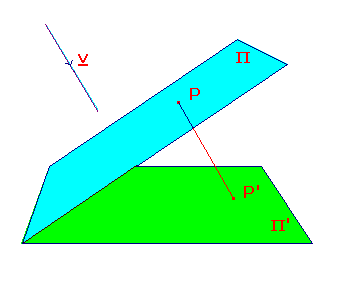turn out to generate the affine group A(2). The definition is
purely geometric. It can be motivated by considering the
relationship between all the shadows of an object.
Definition
If Π and Π' are planes in R3, and v is a vector
not parallel
to either, then
parallel projection from Π to Π' along v
is the map from Π to Π' mapping the point P on Π to P',
the point where the line through P parallel to v cuts Π'.
The definition of a parallel projection t from Π to Π' is purely
geometrical.
To obtain an algebraic description, we suppose
that Π and Π' are each
equipped with (rectangular) x- and
y-axes. Then the transformation has a familiar form.
Theorem A1
A parallel projection is an element of A(2).
Although every parallel projection is an affine transformation,
not every affine transformation is a parallel projection. To see
this, we can use the following
Observation
A parallel projection t preserves the lengths of segments
of at least one line.
Proof
If the planes Π and Π' are parallel, then it is easy to see that
the map t preserves the length of every segment.
Otherwise Π and Π' meet in a line L. The points of L are fixed
pointwise by t, so the length of every segment of L is fixed.
Now note that the dilation about O with scale factor 2 doubles
the length of every segment. This is the affine transformation
taking x to 2Ix+0. Thus, we have an affine transformation
which is not a parallel projection.
However, we can obtain any affine transformation by
composing parallel projections:
Theorem A2
The affine group A(2) is generated by parallel projections.
